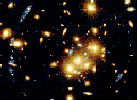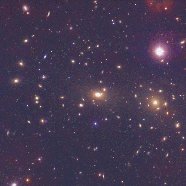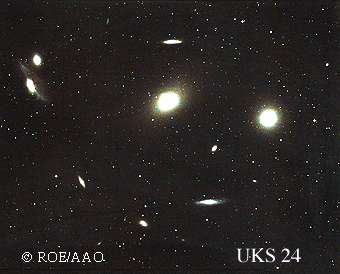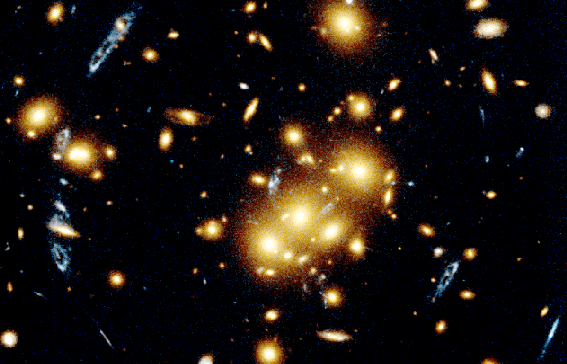Clusters of Galaxies


| Gene Smith's Astronomy Tutorial Clusters of Galaxies |
 |

 |
Most galaxies are found in gravitationally-bound groups called "clusters". Clusters can be rich, with several thousand galaxies, or poor, with only 20 or 30 members. The Local Group, the cluster to which our own Milky Way galaxy belongs, is made up of about 30 galaxies. |
Clusters of galaxies are classified by their properties;richness (number of members),shape (spherical,flattened, or irregular),and galactic content (spiral-rich,spiral-poor, or elliptical-rich),for example. Some are strong radio sources, while others emit x-rays. The richest nearby cluster is Virgo, 60 million light years from the Milky Way. It contains about 2500 galaxies, mostly ellipticals.

We reside in a small group called the
Local
Group which is dominated by
two giant spiral galaxies, Andromeda and our own Milky Way. In addition to
Messier 33, an intermediate mass Sc galaxy, there are 15 ellipticals and 13
irregular galaxies in the cluster, including the Magellanic Clouds, our
Galaxy's satellites, Messier 32 and NGC 205, satellites of Andromeda. The
group has a size of about 3 million l.y., and has a total mass
of 5 x 1012M

The Virgo Cluster, about 50 million l.y. away, is the nearest regular cluster of galaxies with several hundred members. Our Local Group is an outlying member of a "supercluster" of galaxies of which the Virgo Cluster is the dominant member.

The Hubble Space Telescope has provided the first opportunity to look back into the early universe at clusters. Billions of years ago, clusters contained many more spiral galaxies than they do today. They were probably disrupted over time by collisions and mergers within the clusters.

CL 0024+1654 is a large cluster of galaxies located 5 billion light-years from Earth. It is distinctive because of its richness (large number of member galaxies), and its magnificent gravitational lens. The blue loops in the foreground are lensed images of a spiral galaxy located behind the cluster.
Cluster Links

![]() Dark Matter
Dark Matter
![]() Galaxies
Galaxies
![]() Outreach & Education
Outreach & Education
![]() CASS Home
CASS Home
Comments?
Gene
Smith
Conducted by:
Prof. H. E. (Gene) Smith
CASS 0424 UCSD
9500 Gilman Drive
La Jolla, CA 92093-0424
Last updated: 26 April 1999